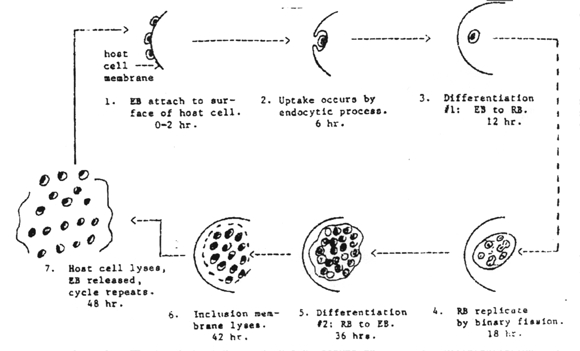Rickettsias Differ From Chlamydias in That Rickettsias
Chlamydias and rickettsias are unusual bacteria because they do not have cell walls. Rickettsias differ from chlamydias in that rickettsias.

Difference Between Chlamydia And Rickettsia Compare The Difference Between Similar Terms
The rickettsia are extremely small gram-negative rod-shaped coccoid or pleomorphic bacteria with limited metabolic capabilities.

. Chlamydial and rickettsial diseases pose a hazard to man and to domesticated and wild animals. C Require an arthropod for transmission. Rickettsiae are cocco-bacillary to coccal in shape varying in size from 03 p in.
Rickettsii transmitted by ticks that must remain attached for hours in order to transmit the disease. The Family Rickettsiaceae contains three genera. Originally classified in the genus Rickettsia- however have different rRna sequence thicker cell wall minimal slime layer.
The virulence mechanisms which aid the establishment of these obligate intracellular parasites in the eukaryotic host are still not within our grasp. Rickettsia replicates in cytoplasm freely chlamydia replicates in endosomes 3. D form elementary bodies.
These organisms have unusual and more exacting growth requirements. C require an arthropod for transmission. Ment of the Chlamydias and.
They cause typhus and other diseases while chlamydia is uncountable any of several common often asymptomatic sexually transmitted diseases caused by the microorganism. Both are obligatory intracellular parasitespathogens. These two bacteria have small pleomorphic coccobacillary forms.
They cause different disease--most rickettsia cause rashes high fevers and nasty headaches. How does chlamydia differ from other bacteria in that they. They are recently recognized agents of several diseases especially in.
C require an arthropod for transmission. Rickettsias are cevtored by an arthropod insect Rickettsias. Experts are waiting 247 to provide step-by-step solutions in as fast as 30 minutes.
B Are intracellular parasites. Rickettsia can make some but not enough they cannot be cultured on non-living artificial media. Up to 24 cash back Rickettsia Rocky mountain spotted fever caused by R.
Both these bacteria are pathogenic microorganisms. Lack cell walls b. 15 Rickettsias differ from chlamydias in that rickettsias A are gram-negative.
Chlamydia and Rickettsia are grams negative bacteria. Rickettsial diseases are difficult to diagnose even by health care providers experienced with these diseases. Chlamydia is considered to be completely dependent on its host for supply of ATP and other energy-rich molecules whereas Rickettsia utilizes cytosolic ATP only during an early phase of the infectious cycle 28.
Rickettsias differ from chlamydias in that rickettsias a are gram-negative. Want to see this answer and more. B Are intracellular parasites.
Chlamydia cannot make any ATP whatsoever. B are intracellular parasites. Scrub typhus caused by O.
Response times may vary by subject and question complexity. Major difference between Rickettsias chlamydias. D form elementary bodies.
To introduce the rickettsia chlamydia and mycoplasma as distinct groups of degenerate bacteria. Rickettsias and Chlamydias are different from most other bacteria in that they __________. Require other bacteria to help them reproduce c.
Median response time is 34 minutes for paid subscribers and may be longer for promotional offers. B are intracellular parasites. This group contains many important pathogens.
Rickettsia Ehrlichia and Coxiella. Mites- reservoir and vector or Orientia transmit bacteria via transovarian transmission to offspring which then spreads it among rodents and humans. C Require an arthropod for transmission.
Ehrlichia species are classified in the same family as rickettsiae. C Require an arthropod for transmission. To differentiate the rickettsia chlamydia and mycoplasma on the basis of cell structure metabolism genetic characteristics pathogenicity routes of disease transmission and methods of diagnosis.
Rickettsias differ from chlamydias in that rickettsias A Are gram-negative. B Form elementary bodies. Rickettsias Rickettsia Rickettsia rickettsii Rocky Mountain spotted fever Most severe and common rickettsial illness Hard ticks transmit among humans and rodents Most infected individuals develop rash on trunk and appendages Approximately 5 of patients die Treated with antimicrobials Prevention involves avoiding ticks.
An incubation of 2-6 days is followed by a severe headache chills fever aching and nausea. As nouns the difference between rickettsia and chlamydia is that rickettsia is any of a group of gram-negative bacteria of the genus rickettsia carried as parasites by ticks fleas and lice. D Form elementary bodies.
Instead they are innoculated into living cells for. E lack cell walls. Microbes the different intracellular ecological mches occupied by these bacteria are sustained long enough by the host to provide the requisite environment for their propagation and disseminatiOn to nearby cells.
All of the members of the Family Rickettsiaceae are obligate intracellular parasites due to a highly permeable. The rickettsiae chlamydiae and mycoplasmas are bacteria that are different from the typical bacteria discussed above. Several of these organisms are significant pathogens.
C Are intracellular parasites. Chlamydia and Rickettsia are 2 groups of Gram-negative bacteria. Recent knowledge of the biochemical stratagem the metabolic capabilities and the genetic diversity of these microbes illustrate fundamental.
Rickettsias differ from chlamydias in that rickettsias A Lack cell walls. Most symptomatic rickettsial diseases cause moderate illness but some Rocky Mountain and Brazilian spotted fevers Mediterranean spotted fever scrub typhus and epidemic typhus may be fatal in 2060 of untreated cases. After 2-6 days a maculopapular rash develops first on the extremities including palms and soles and.
The most important rickettsial pathogens are Rickettsia prowazekii epidemic typhus Rickettsia rickettsii Rocky Mountain spotted fever Rickettsia akari rickettsialpox and Coxiella burnetii Q fever. They must steal host ATP to live. Rickettsia has a tropism for endothelial cells lining blood vessels chlamydia clams out in columnar epithelium.
The rod-shaped chlamydiasbrucellarickettsias are intracellular parasitic members of the alphaproteobacteria The rod-shaped chlamydiasbrucellarickettsias are intracellular parasitic members of the alphaproteobacteria. How is Rickettsia different from Chlamydia. What are the Similarities Between Chlamydia and Rickettsia.
D Form elementary bodies. Are obligate intracellular parasites.

Rickettsia Chlamydia Mycoplasma

Rickettsia Chlamydia And Mycoplasmas Ppt Video Online Download

Comments
Post a Comment